The Wave Wins Safe Trestles Competition
By Bustler Editors|
Wednesday, Sep 22, 2010
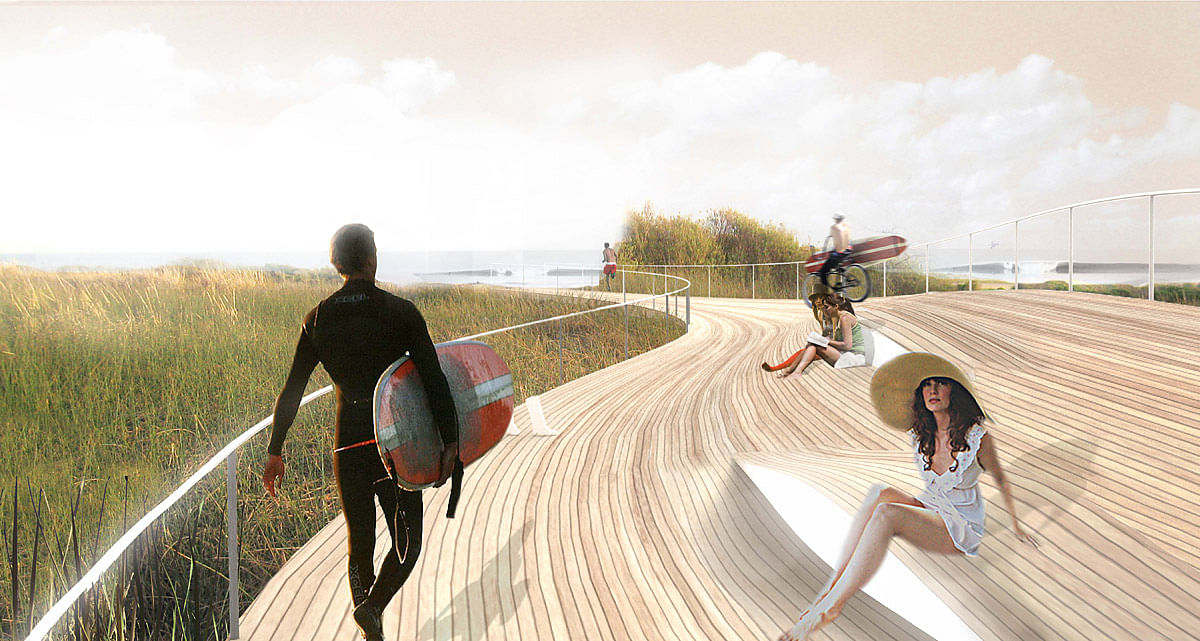
Related
The entry "The Wave" by Los Angeles-based practice CO-LAB design office has been announced Phase 2 Overall Winner of Safe Trestles - an ideas competition that explores ways to create safe, low-impact access to Trestles. Earlier this year, a group of finalists had been selected that qualified to move on to Phase 2 (previously on Bustler).
Project Description:
The Wave’s primary goals are to increase the safety of the path to Trestles and protect its fragile beach ecology. There have been a number of close calls as people illegally cross the railroad tracks to get to this renowned surf break. We provide a safe rail crossing so visitors may cross the railroad without danger. The Wave also provides a single path over the wetland, bringing visitors close to this unique ecology while protecting it from rogue trails, and providing visitors with views and information about the landscape they are traversing. The Wave’s subtle regraded path, integrated signage and beautiful form provides a unique design solution for the unique landscape at Trestles. The Wave proposal will keep this landscape safe, protected and pristine, for generations to come.

We investigated several options for achieving a gentle and constant slope for the path. We went to the site and walked alternative paths to better understand the possibilities of different slope options, and the resulting qualities of each option. In essence we feel that the great efforts it would take to achieve a 5.2% slope would detract from the qualities that make the site so special. A 5.2% slope path, in the form of an extended built deck or a substantially cut and filled landscape trail (or a hybrid combination), would domesticate this otherwise pristine and ‘wild’ pocket of natural landscape. Additionally, there is near direct access to the beach to the North and South of Trestles Lowers, via paved surfaces that will provide much easier access even if a 5.2% sloped path were constructed.

Which raises the question - to what extent should we pursue the stated competition objective of 5.2% slope for universal access? To what financial expense, and how much detriment to the special experience of Trestles, should the site suffer? Part of why people go to Trestles is to delight in being immersed in nature, to experience the wild aspect of a dirt trail. To keep the special qualities of the existing path we propose maintaining an on grade path all the way from the special event parking to the rail crossing. This will keep the experience of Trestles wild.
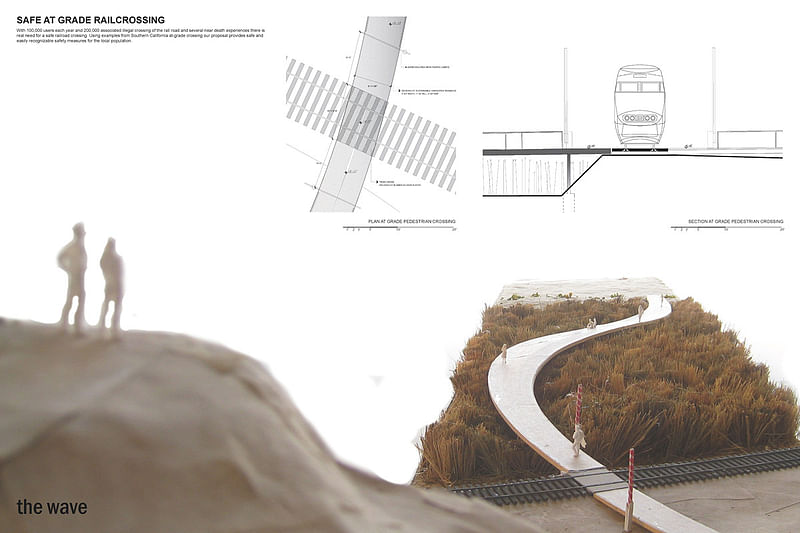
In light of the preceding questions we propose a path with a constant 6.2% slope. This 6.2% slope is a middle point between regrading the entire trail to 5%--requiring substantial gabion wall constructions or isolating elevated walkways, and leaving the path dangerously steep. The proposed pathway greatly improves ease of access by creating a new trailhead at a lower elevation, bypassing corn dog and providing a consistent slope that works with the topography of the site. We believe this regraded option will be less expensive to build, and easier to maintain. Providing more universal asscess without domesticating Trestles, the new trail will also decrease the speed of bicyclists. On The Wave visitors do not have to worry about twisting an ankle or tumbling down a steep slope and arrive at the beach or home resembling a corndog. This 6.2% slope will maintain the overall qualities of wildness and the connection with nature and direct access to it...all that we all love about trestles.
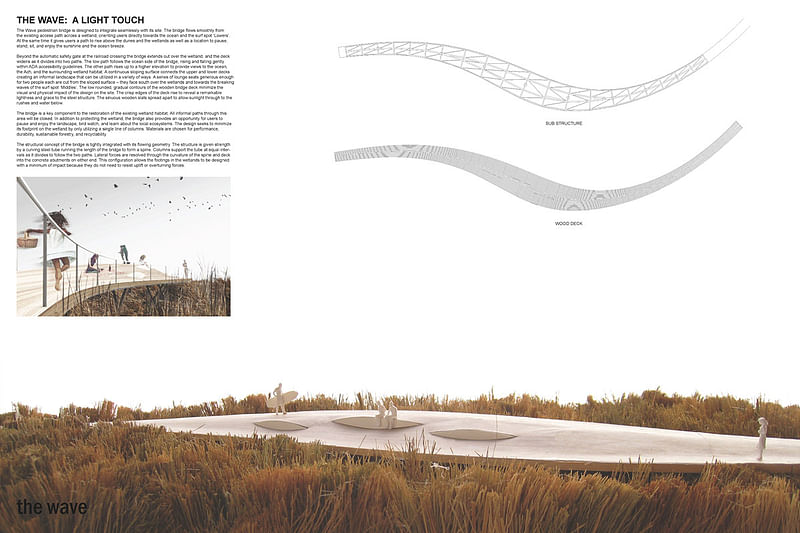
Beyond the automatic safety gate at the railroad crossing the bridge extends out over the wetland, and the deck widens as it divides into two paths. The low path follows the ocean side of the bridge, rising and falling gently within ADA accessibility guidelines. The other path rises up to a higher elevation to provide views to the ocean, the Ach, and the surrounding wetland habitat. A continuous sloping surface connects the upper and lower decks creating an informal landscape that can be utilized in a variety of ways.
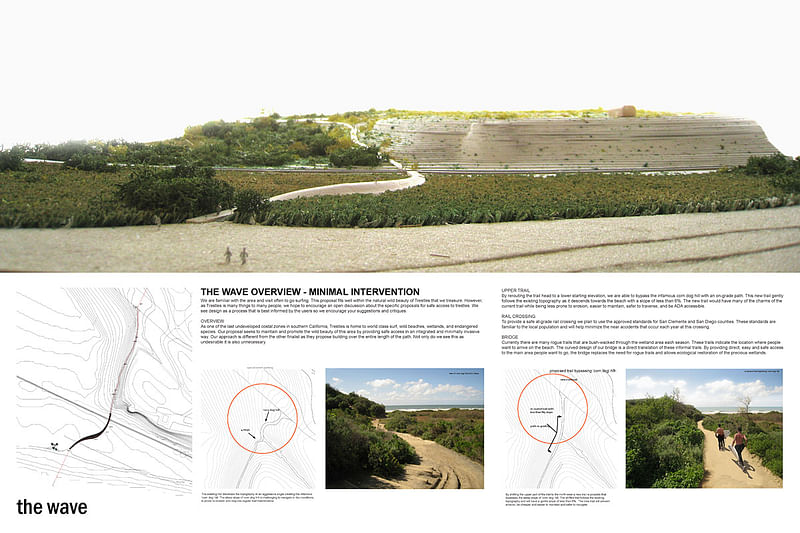
The bridge is a key component to providing a safe and easy access way to the beach. The pathway will also allow the restoration of the existing wetland habitat. All informal paths through this area will be closed. The bridge also provides an opportunity for users to pause and enjoy the landscape, bird watch, and learn about the local ecosystems. The design seeks to minimize its footprint on the wetland by only utilizing a single line of columns. Materials are chosen for performance, durability, sustainable forestry, and recyclability.
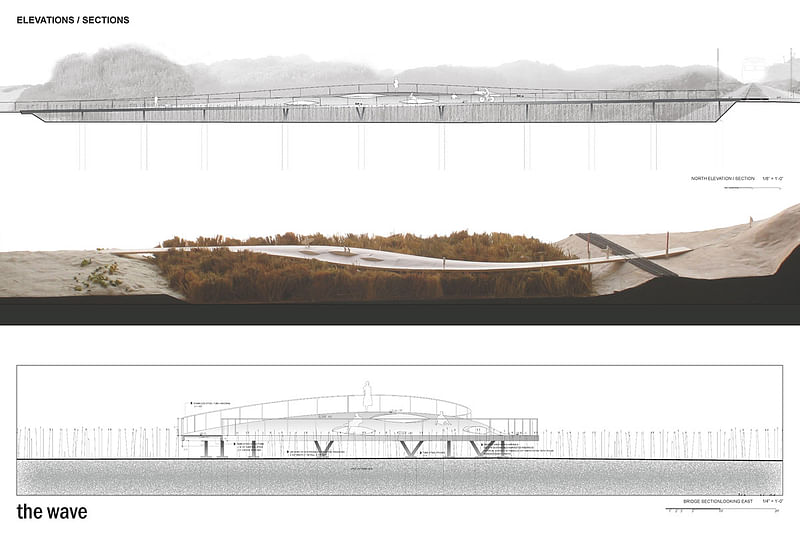
A series of lounge seats are pulled up from the sloped surface – they face south over the wetlands and towards the breaking waves of the surf spot ‘Middles’. The low rounded, gradual contours of the wooden bridge deck minimize the visual and physical impact of the design on the site. The crisp edges of the deck rise to reveal a remarkable lightness and grace to the steel structure. The sinuous wooden slats spread apart to allow sunlight through to the rushes and water below.

Share
0 Comments
Comment as :